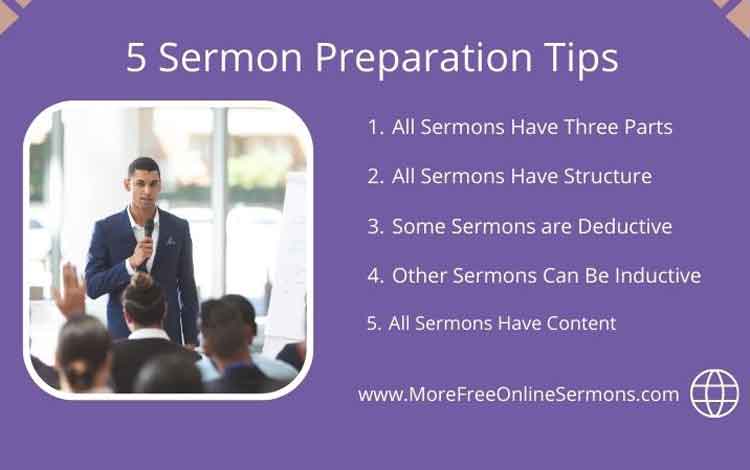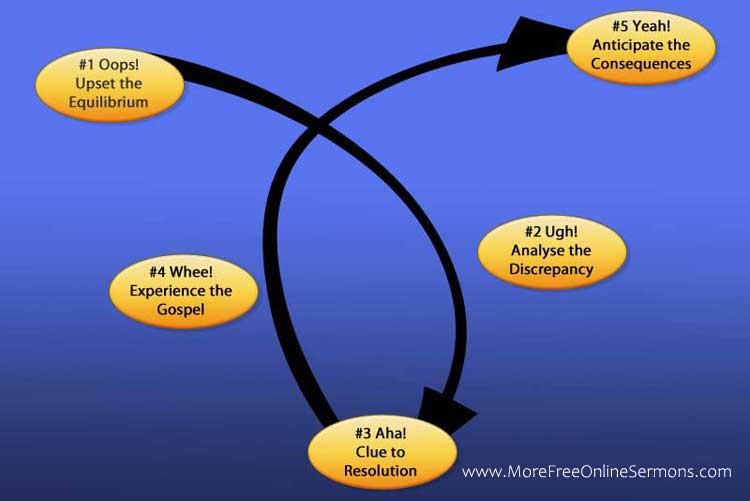It’s not easy writing biblical sermons from week to week for your congregation. These 5 sermon preparation tips will help you prepare sermons that work with structure, sequence and natural flow.
The 5 sermon preparation tips are: 1) all sermons have three parts, 2) all sermons have structure, 3) some sermons are deductive, 4) other sermons can be inductive, and 5) all sermons need content.

5 Sermon Preparation Tips
Generally speaking, the most difficult part of sermon preparation is not the study or analysis of the text of Scripture (generally referred to as exegesis) but the presentation of the main preaching point (or topic) of the text of Scripture (generally referred to as exposition).
By the way, I have never found the study and analysis of Scripture difficult; however, in my early days as a preacher, I did struggle in the presentation of the main preaching point (or topic) of the Scripture. Once I developed a method for presenting the main preaching point (or topic) of the text of Scripture, I found that sermon preparation became a whole lot easier.
Let me say this: having a clear presentational method is absolutely essential for preachers who preach week in and week out.
With all that in mind, here are 5 sermon preparation tips that helped me prepare sermons week in and week out.
1. All Sermons Have Three Parts
I often compare a sermon to an airplane flight. You have the take off, the flight and the landing.
A sermon has an introduction (the take off), the body (the flight) and a conclusion (the landing). A great sermon has a powerful take off (introduction), an interesting flight (body) and a memorable landing (conclusion).
Let me also say that the introduction introduces the sermon, that is, the main preaching point (or topic); the body of the sermon, which is your sermon outline, expands and explains your main preaching point (or topic) and the conclusion reinforces the main preaching point (or topic).
2. All Sermons Have Structure
Like it or not, sermons have structure.
Sermon structure helps the preacher or speaker present the message of the text in a way that it is easy for the congregation or audience to follow and understand. In other words, it has order and a natural flow when presented to the congregation or audience.
You can structure sermons in three ways – deductively, inductively or a bit of both.
3. Some Sermons Are Deductive
A deductive sermon begins with the main preaching point (or topic) followed by the sub-points and incidental points.
You may want to preach a deductive sermon from James 1:13-18. The main preaching point (or topic) in this passage is: Resisting Deadly Temptation. The sub-points could be: The source of temptation, the steps in temptation and the solution to temptation. Your sermon outline could look like this:
INTRODUCTION
There are Three Avenues for resisting deadly temptation. They involve . . .
1. The Source of Temptation (1:13) Two facts to consider . . .
- God is not the source of temptation
- Temptation lies within man himself
2. The Steps in Temptation (1:14-15) Three steps to note:
- Temptation itself
- Desire to sin
- Sin leads to death
3. The Solution to Temptation (1:16-17) Three truths to grasp:
- Understand the deception
- Understand the character of God
- Understand the gift of God
CONCLUSION
You can check out this sermon by clicking on the follow link – Preaching Sermon From James 1.
4. Other Sermons Can Be Inductive
An inductive sermon begins with the sub-points and incidental points leading to the climax of the main preaching point (or topic).
Often, an inductive sermon is used to preach the narratives in Scripture.
There are several ways to structure an inductive sermon. However, Lorwy’s loop is an inductive method that works perfectly with the narratives of Scripture.
Lowry’s Loop has five stages to its layout.
- OOPS – Upsetting the Equilibrium (Tension Introduced)
- UGH – Analysing the Discrepancy (Tension Understood)
- AHA – Disclosing the Clue to Resolution (Tension Resolved)
- WHEE – Experiencing the Gospel (Tension Gone)
- YEAH – Anticipating the Consequences
Lowry’s Loop simply allows the narrative to unfold scene by scene in order to tell the story of the narrative with its main intention.

I have prepared an inductive sermon outline to show you have Lowry’s Loop works in practice.
There is a narrative in Luke 5:1-11 where a simple fishing expedition set the stage for Peter to get a glimpse of Jesus’ majesty, which transformed his life forever.
The main preaching point (or topic) of this narrative is that a glimpse of Jesus’ majesty is life transforming. However, Peter nearly missed this opportunity because he struggled with being told what to do by Jesus.
- We don’t always like being told what to do
- Peter struggled with being told what to do (Luke 5:1-5a)
- Nevertheless, he conceded and got a glimpse of Jesus’ majesty (Luke5:5b-7)
- Getting a glimpse of Jesus’ majesty is life transforming (Luke 5:8-11)
- Obeying Jesus leads to glimpses of His transforming majesty in our lives!
It is important to realize that the introduction is inclusive in the OOPS stage when the tension is introduced and the conclusion is inclusive in the YEAH stage when anticipating the consequences.
Notice also in point 1 that the tension is introduced, in point 2 the tension is explained, in point 3 and 4 the tension is resolved and in point 5 the tension dissipates because now we see that obedience to Jesus leads to transformation.
You can check out this sermon by clicking on the following link – Bible Sermon From Luke 5.
5. All Sermons Have Content
I work on the principle that I never write a sermon until I have completed the sermon outline. It doesn’t matter if it is a deductive, inductive or a bit of both. The sermon outline always comes first.
Once I have completed the sermon outline, I add content and illustrations.
I write a full preaching manuscript. I don’t preach the manuscript word for word. The sermon manuscript simply helps me put the content and ideas together in order to find the best ways to illustrate and apply the different points to my congregation or audience.
Once I have finished putting the content and illustrations in place, I then write an introduction and the conclusion.